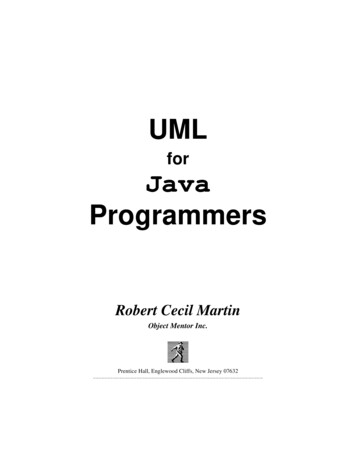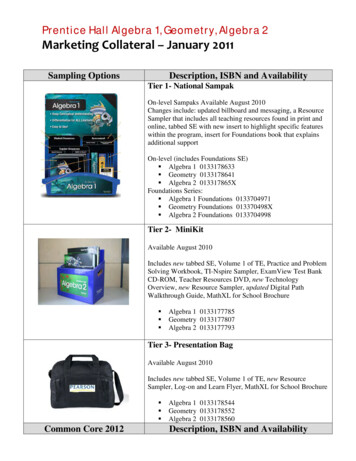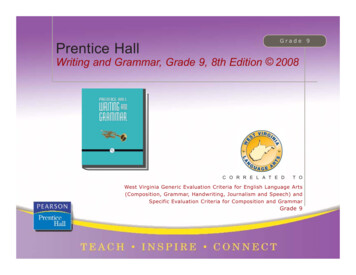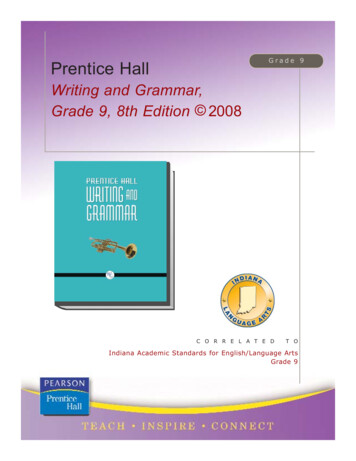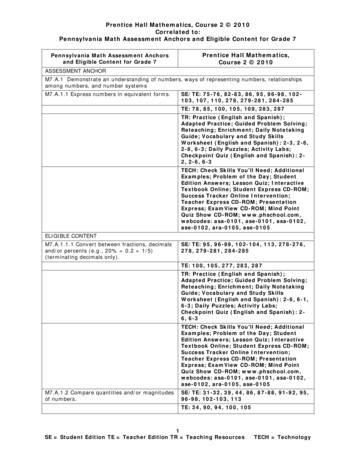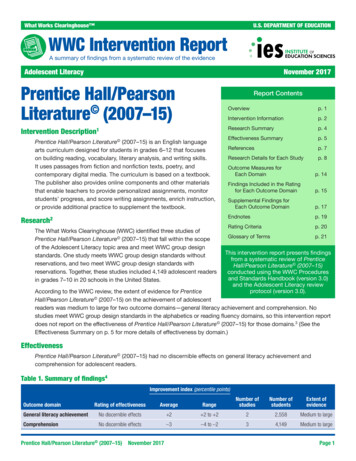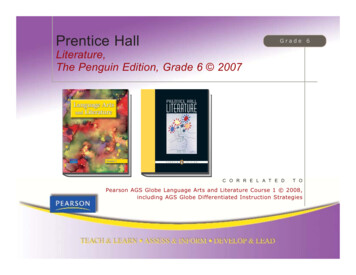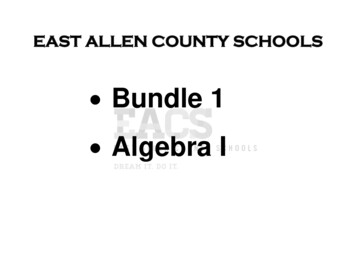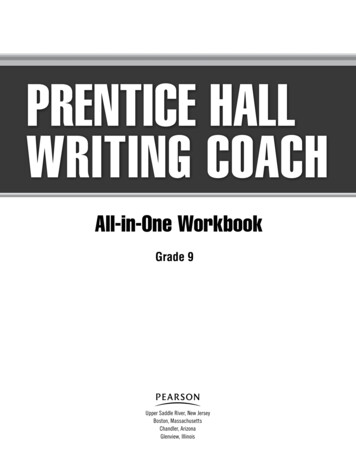
Transcription
Prentice HallWRITING COACHAll-in-One WorkbookGrade 9Upper Saddle River, New JerseyBoston, MassachusettsChandler, ArizonaGlenview, Illinois
Copyright Pearson Education, Inc., or its affiliates. All Rights Reserved. Printed in theUnited States of America. This publication is protected by copyright, and permission shouldbe obtained from the publisher prior to any prohibited reproduction, storage in a retrievalsystem, or transmission in any form or by any means, electronic, mechanical, photocopying,recording, or likewise. The publisher hereby grants permission to reproduce these pages, inpart or in whole, for classroom use only, the number not to exceed the number of students ineach class. Notice of copyright must appear on all copies. For information regarding permissions, write to Rights Management & Contracts, Pearson Education, Inc., One Lake Street,Upper Saddle River, New Jersey 07458Pearson, Prentice Hall, and Pearson Prentice Hall are trademarks, in the U.S. and/or othercountries, of Pearson Education, Inc., or its affiliates.ISBN-13: -253010-42 3 4 5 6 7 8 9 10V03114 13 12 11
TABLE OF CONTENTSPart 1 Introduction. . 1AGrammarChapter 13: The Parts of SpeechNouns and Pronouns. 1Verbs. 3Adjectives and Adverbs. 6Prepositions, Conjunctions, and Interjections. 8Words as Different Parts of Speech.11Chapter 14: Basic Sentence PartsSubjects and Predicates. 12Hard-to-Find Subjects. 14Complements. 18Chapter 15: Phrases and ClausesPhrases. 22Clauses. 25Chapter 16: Effective SentencesThe Four Structures of Sentences. 30The Four Functions of Sentences. 31Sentence Combining. 32Varying Sentences. 33Avoid Fragments and Run-ons. 36Misplaced and Dangling Modifiers. 38Faulty Parallelism. 40Faulty Coordination. 44UsageChapter 17: Verb UsageVerb Tenses. 46The Correct Use of Tenses. 50The Subjunctive Mood. 55Voice. 57Chapter 18: Pronoun UsageCase. 59Special Problems With Pronouns. 63Copyright Pearson Education, Inc., or its affiliates. All rights reserved.iii
Chapter 19: AgreementSubject–Verb Agreement. 65Pronoun–Antecedent Agreement. 69Special Problems With Pronoun Agreement. 72Chapter 20: Using ModifiersDegrees of Comparison. 75Making Clear Comparisons. 78Chapter 21: Miscellaneous Problems in UsageNegative Sentences. 81Common Usage Problems. 84MechanicsChapter 22: CapitalizationCapitalization in Sentences. 85Proper Nouns. 87Other Uses of Capitals. 89Chapter 23: PunctuationEnd Marks. 91Commas. 95Semicolons and Colons. 109Quotation Marks, Underlining, and Italics.112Hyphens. 121Apostrophes. 127Parentheses and Brackets. 131Ellipses, Dashes, and Slashes. 133Part 2 Introduction and Contents. . 137Vocabulary and Spelling Practice. 138Part 3 Introduction and Contents. . 183Academic and Workplace Skills Activities. 184Copyright Pearson Education, Inc., or its affiliates. All rights reserved.iv
Part 1: Grammar, Usage,and MechanicsINTRODUCTIONPart 1 of the All-in-One Workbook consists of worksheets that provide additionalsupport for the skills learned in the grammar chapters of Prentice Hall WritingCoach. Each worksheet provides students with instruction on a grammar skill. Theworksheets then provide two practice activities on the skill as well as a speaking andwriting activity.The extra practice provided in these worksheets focuses on the following areas: Grammar: These worksheets provide students with practice learning how toidentify and use the parts of speech, basic sentence parts, phrases, and clauses.They also give students practice identifying and creating effective sentences. Usage: These worksheets provide practice with using verbs and pronouns,making words agree, and using modifiers. Mechanics: These worksheets give students practice with proper use ofpunctuation and capitalization in their sentences.Copyright Pearson Education, Inc., or its affiliates. All rights reserved.1A
Name1DateNOUNSA noun is the part of speech that names a person, a place, a thing, or an idea.There are different types of nouns. See the examples below.Common nounclass of person, place, or thinggirl, city, monthProper nounspecific person, place, or thingMaria, Dallas, DecemberConcrete nounsomething you can see, touch, taste, hear, or smelltable, hat, penAbstract nounsomething you can’t perceive through your sensesloyalty, hope, freedomPractice A Identifying NounsRead each sentence. Then, underline the nouns in each sentence.Example: Our decision was to eat dinner before the movie.Answer: Our decision was to eat dinner before the movie.1. The present is on the table.7. Her family moved to the United States fromChina.2. Please take Sally to the dentist.3. My brother slept through the movie.8. Gymnastics requires balance and strength.4. Call the office after the package arrives.9. Our choir visited the White House inWashington, D.C.5. The weather in Chicago is cold in January.6. The firefighter received a medal for her bravery.10. The friendship between Rich and Tom haslasted for years.Practice B Labeling NounsRead each sentence. Then, on the line provided, identify whether each underlined noun is (1) common orproper and (2) concrete or abstract.Example: Did you give your pencil to Paul?Answer: pencil—common, concrete; Paul—proper, concreteCopyright Pearson Education, Inc., or its affiliates. All Rights Reserved.1. Your friendship is important to me.2. Aunt Mary visited my family yesterday.3. Please pass the potatoes.4. My uncle lives in Florida.5. A puppy needs a lot of attention.6. Can I use the telephone to call Grandpa?7. Our deepest hope is for freedom.8. Have you read Tom Sawyer by Mark Twain?9. My frustration grew over time.10. No other bridge is as beautiful as the Brooklyn Bridge.Writing and Speaking ApplicationWrite a two-sentence description of your classroom, using at least six nouns. Circle the nouns. Then,take turns reading your sentences with a partner. Your partner should listen for and name the nouns inyour sentences. Then, switch roles with your partner.– 1 The Parts of Speech –
Name2DatePRONOUNSPronouns are words that stand for nouns or for words that take the placeof nouns.Pronouns get their meaning from the words they stand for. These words are calledantecedents. Reciprocal pronouns each other and one another refer to a pluralantecedent. They express a mutual action or relationship.Show that you can use and understand the function of pronouns by completing the following exercises.Practice A Identifying AntecedentsRead each sentence below. Then, draw an arrow that points from the underlined pronoun to itsantecedent.Example: Michael loves his school.Answer:Michael loves his school.1. Mary did the job herself.2. Jamal works hard at his job.3. Successful students do their homework.4. Rachel took her daughter to the park.5. Andrew likes work. He spends a lot of time there.6. Roderick wrote his mom a letter.7. If Jessie does the chores, she will get an allowance.8. Dennis is very kind to his employees.9. When Kate exercises, she feels better.10. If Cameron does the work, he will succeed.Copyright Pearson Education, Inc., or its affiliates. All Rights Reserved.Practice B Identifying Reciprocal PronounsRead each sentence below and underline the reciprocal pronouns.Example: They always help each other.Answer: They always help each other.1. At Christmas, we give each other gifts.2. Good people are kind to one another.3. The men shook hands with each other.4. It is obvious that they are fond of one another.5. The children cooperate with one another.Writing and Speaking ApplicationWrite five sentences that include pronouns. Circle the pronouns and draw an arrow to theirantecedents. Read your sentences to a partner, who will identify the pronouns and their antecedents.Then, switch roles with your partner.– 2 The Parts of Speech –
Name3DateACTION VERBS AND LINKING VERBSA verb is a word or group of words that expresses time while showing an action, a condition,or the fact that something exists.There are different types of verbs. See the examples below.Action verbtells what action someoneor something is performinggo: is going, wentrun: is running, ranfly: is flying, flewlearn: is learning, learnedLinking verbconnects its subject with a noun, apronoun, or an adjective that identifiesor describes the subjectbe: is, am, was, were, could be, would be, has beenfeel: is feeling, feltbecome: is becoming, becamePractice A Identifying Action VerbsRead each sentence. Underline the action verb.Example: Susan ran around the track.Answer: Susan ran around the track.1. Tyrell plays the guitar.4. Connie helps a lot of people.2. Robert works at the factory.5. Albin cooks delicious food.3. Sarah drank the juice.6. Heidi swam to shore.Practice B Identifying Linking VerbsRead each sentence. Underline the linking verb.Example: Cathy feels sick.Answer: Cathy feels sick.1. Richard is a soldier.2. Tamara’s voice sounds wonderful.Copyright Pearson Education, Inc., or its affiliates. All Rights Reserved.3. Her son became a doctor.4. He felt better after we talked.5. Jason appeared upset.Practice C Distinguishing Between Action Verbs and Linking VerbsUnderline the verbs in the following sentences. Then, write whether the verb is an action verb or alinking verb.Example: He flies jets for a living.Answer: He flies jets for a living. action verb1. After dinner, she became sick.2. We played the best game ever!3. Ashley was so happy about the puppy.4. Jared is my best friend.5. The children argued about television shows.Writing and Speaking ApplicationWrite five sentences, some that use an action verb and some that use a linking verb. Read thesentences to a partner. Your partner should listen for and name the verb and tell whether it is an actionverb or a linking verb. Then, switch roles with your partner.– 3 The Parts of Speech –
Name4DateTRANSITIVE AND INTRANSITIVE VERBSA transitive verb directs action toward someone or something named in the sentence.An intransitive verb does not direct action toward anyone or anything named in the sentence.The word that receives the action of a transitive verb is called the object of the verb. You can determinewhether a verb has an object by asking whom or what after the verb.Transitive:Intransitive:The boy lost his jacket. (Lost what? his jacket)The baby cried loudly. (Cried what? [no answer])Practice A Identifying Transitive Verbs and Their ObjectsRead each sentence. Then, underline the verb and circle the object of the verb.Example: Mom baked a delicious cake.Answer: Mom baked a delicious cake.1. Tim sold hot chocolate at the game.2. Kelly wore glasses.3. Mom and Dad ate all of the pie.4. The kitten scratched my hand.5. I pictured success in my mind.6. Chris took the garbage to the curb.7. Michael forgot his backpack.8. Belle asked several questions.9. The dog ate the leftovers.10. The doctor washed his hands.Practice B Distinguishing Between Transitive Verbs and Intransitive VerbsRead each sentence. Then, write the action verb and label it transitive or intransitive.Copyright Pearson Education, Inc., or its affiliates. All Rights Reserved.Example: The baby cried for her bottle.Answer: cried—intransitive1. Miette walked to the store.2. James did his homework.3. Ethan played his guitar all morning.4. The grass grew quickly.5. The plane holds over a hundred people.6. Chloe sprained her ankle.7. Benjamin runs faster than anybody else.8. Mr. Young wants a new dog.9. Steve forgot the party.10. His mom washed the dishes.Writing and Speaking ApplicationWrite four sentences, two with transitive verbs and two with intransitive verbs. Read your sentences toa partner. Your partner should listen for each verb and name it transitive or intransitive. Then, switchroles with your partner.– 4 The Parts of Speech –
Name5DateVERB PHRASESA verb phrase consists of a main verb and one or more helping verbs.One or more helping verbs may precede the main verb in a verb phrase. For example, in the sentence,“I will be arriving at school on time,” will and be are helping verbs, and arriving is the main verb.Common helping verbs are shown in the table dwillmaywouldmightwere(all forms of be)mustPractice A Recognizing Verb PhrasesRead each sentence. Then, write the verb phrase on the line provided.Copyright Pearson Education, Inc., or its affiliates. All Rights Reserved.Example: I will be taking science first period.Answer: will be taking1. You should have finished the paper beforewatching TV.6. I have seen this movie four times.2. My family is leaving next week.7. Nicole will be working tomorrow.3. Truong is painting his house.8. Chad has been posting updates from his trip.4. My dog was not expecting two shots today.9. Cathy is raising five kids.5. That car does use a lot of gas.10. He is planning a trip to Japan.Practice B Identifying Helping Verbs and Main VerbsRead each sentence. Then, underline the helping verbs and circle the main verbs.Example: She is using her mom’s computer.Answer: She is using her mom’s computer.1. They are adopting a child next month.6. Grandma might learn karate.2. Mr. Rose should be making dinner by now.7. I have seen snow in Telluride in July.3. Temperatures are climbing.8. Antal will play guitar in a concert tonight.4. You do want dessert, right?9. Dad was praising the dog.5. I might go to community college for my firstyear.10. I am getting a job next semester.Writing and Speaking ApplicationWrite three sentences that use verb phrases, and underline the helping verbs. Then, read yoursentences to a partner. Your partner should identify the main verbs. Switch roles with your partner andrepeat the exercise.– 5 The Parts of Speech –
Name6DateADJECTIVESAn adjective is a word used to describe a noun or pronoun or to give it a more specificmeaning.An adjective answers one of four questions about a noun or pronoun: What kind? Which one? Howmany? How much? See the examples in the table below.beautiful gardensWhat kind of gardens?that lessonWhich lesson?sixty-seven yearsHow many years?boundless energyHow much energy?Practice A Identifying AdjectivesRead the sentences below. Then, underline the adjective or adjectives in each sentence. Remember thatarticles are adjectives, too!Example: The tall, handsome boy goes to college.Answer: The tall, handsome boy goes to college.1. That game went on forever!6. The broken window lets in the cold.2. I am listening to classical music.7. She enjoys making complicated recipes.3. Cesar loves putt-putt golf.8. The old, slow computer has to go.4. Some people spend long hours at work.9. Modern art speaks to my soul.5. Allen wants a red suit.10. Reading is my favorite activity.Practice B Identifying Nouns Used as AdjectivesRead each sentence. Then, write the noun that is used as an adjective in each sentence.Example: She went to the work meeting.Answer: workCopyright Pearson Education, Inc., or its affiliates. All Rights Reserved.1. It is time to wash the dinner dishes.2. Did you bring a winter coat?3. I missed band practice all week.4. Nguyen is a basketball player.5. Camilla has a smoothie habit.6. That office building should be torn down.7. The earthquake plan is very detailed.8. Miss Stenberg has fruit salad for lunch.9. He works at an airplane factory.10. She is hoping for an adventure vacation.Writing and Speaking ApplicationWrite a three-sentence description of your family, using at least one adjective in every sentence. Circlethe adjectives. Find a partner and take turns reading your sentences. Your partner should listen for andname the adjective or adjectives in each sentence. Then, switch roles with your partner.– 6 The Parts of Speech –
Name7DateADVERBSAn adverb is a word that modifies a verb, an adjective, or another adverb.When an adverb modifies a verb, it will answer one of the following questions: Where? When? In whatway? To what extent? See the examples below.Where?The book was here.When?He never walked the dog.In what way?Thomas gently corrected her.To what extent?They completely lost track of time.Practice A Recognizing AdverbsRead each sentence. Then, write the adverb in each sentence.Example: She ran quickly to the car.Answer: quickly1. He yelled loudly when he broke his rib.6. Shane always flosses his teeth.2. That child can sleep anywhere.7. I finally finished that letter.3. I want to travel abroad.8. I will see you soon.4. Moles live underground.9. The package will come tomorrow.5. He accidentally spilled his milk.10. Leila smiled cheerfully.Practice B Identifying Adverbs and the Words They ModifyRead each sentence. Then, write the adverb and the word or words it modifies.Copyright Pearson Education, Inc., or its affiliates. All Rights Reserved.Example: I will arrive eventually.Answer: eventually—will arrive1. Juan is utterly wonderful.2. That bell seldom rings.3. Young professionals are upwardly mobile.4. I sometimes appreciate cold weather.5. He usually arrives about this time.6. Miss Graski practices her cello often.7. The hawk dropped swiftly from the sky.8. She practices medicine thoughtfully.9. Ava will move to Chicago soon.10. He was mortally wounded.Writing and Speaking ApplicationWrite a three-sentence description of how to do something, using at least three adverbs. Circle theadverbs. Then, take turns reading your sentences with a partner. Your partner should listen for andname the adverbs in your sentences. Then, switch roles with your partner.– 7 The Parts of Speech –
Name8DatePREPOSITIONS AND PREPOSITIONAL PHRASESA preposition relates the noun or pronoun that appears with it to another word in thesentence. A prepositional phrase is a group of words that includes a preposition and anoun or pronoun.Prepositions show relationships that involve location, direction, time, cause, or possession—forexample, above, toward, since, and of. Prepositions come at the beginning of prepositional phrases;the phrases include the preposition and a noun or pronoun that is called the object of the preposition.Practice A Identifying Prepositions and Prepositional PhrasesRead each sentence. Then, write the prepositional phrase in each sentence, and underline thepreposition.Example: Most kids in that school do well.Answer: in that school1. Put the book on the table.6. Lola lives in San Diego.2. That son of Tricia’s is still small.7. I found the shoe under the bed.3. Be here in the morning.8. Juanita studied into the night.4. There was a competition between the twobrothers.9. Don’t leave without your hat.5. Henry puts the dishes in the sink.10. I found a ring on the beach.Practice B Identifying Prepositions and Their ObjectsRead each sentence. Then, underline the preposition and circle the object of the preposition.Copyright Pearson Education, Inc., or its affiliates. All Rights Reserved.Example: The bridge goes over the river.Answer: The bridge goes over the river.1. The children return at sunset.2. The flight was delayed because of an equipment problem.3. The family had a party in the park.4. I want to live near the ocean.5. The whale is moving toward the shore.6. The new suit should last for years.7. Ted is the son of a musician.8. Liz is walking to work.9. She says she concentrates better with music.10. I use the bus for transportation.Writing and Speaking ApplicationWrite four sentences with a prepositional phrase in each. Underline the prepositions. Then, finda partner. Your partner should listen for and name the prepositional phrases. Together, identify theobjects of the prepositions. Then, switch roles with your partner.– 8 The Parts of Speech –
Name9DateCONJUNCTIONSA conjunction is a word used to connect words or groups of words.There are three main kinds of conjunctions: coordinating, correlative, and subordinating. These types ofconjunctions are described in more detail in the following chart.CoordinatingconjunctionsThere are only seven. They connect similar parts ofspeech or groups of words that have equal grammaticalweight.and, but, for, nor, or, so, yetCorrelativeconjunctionsThere are only five, and they are paired. They joinelements of equal grammatical weight.both and; either or; neither nor;not only but also; whether orSubordinatingconjunctionsThere are many. They join two complete ideas bymaking one of the ideas dependent upon the other.after, because, although, as if, aslong as, so that, whenever, when,where, as though, in order that, whilePractice A Identifying ConjunctionsRead each sentence. Then, underline the conjunctions. If a sentence has a correlative conjunction,remember to underline both parts.Example: Neither I nor my employees will attend that event.Answer: Neither I nor my employees will attend that event.1. I love skiing, but my knees hate it.6. She eats lunch at her desk when she has to.2. We will either take the car or take the bus.7. Lukas wanted to help, but he didn’t have time.3. I love apples and bananas.8. He will study either Spanish or French.4. Do you want a sandwich or some leftovers?9. Fred likes not only soccer but also basketball.5. I like dessert after I eat dinner.10. While I load the dishwasher, you put the foodaway.Copyright Pearson Education, Inc., or its affiliates. All Rights Reserved.Practice B Identifying Kinds of ConjunctionsRead each sentence below. Then, write the conjunction from each sentence, and label it as coordinating,correlative, or subordinating.Example: She likes to knit while she watches TV.Answer: while—subordinating1. I like to eat spicy food, yet it bothers my stomach.2. She was awake but drowsy.3. While Jack washed the car, Jill mowed the lawn.4. I walk the dog, but the cat walks herself.5. You can have either chocolate or vanilla6. Michelle and James are getting married.7. I have to go to the doctor whether I like it or not.8. Do you prefer flat shoes or heels?9. Kaya listens to music while she does homework.10. I want to play soccer, but my knee can’t take the strain.Writing and Speaking ApplicationWrite three sentences: one that uses a coordinating conjunction, one that uses a correlativeconjunction, and one that uses a subordinating conjunction. Read your sentences to a partner, whoshould identify the type of conjunction used in each sentence. Then, switch roles.– 9 The Parts of Speech –
Name10DateINTERJECTIONSAn interjection is a word that expresses feeling or emotion and functions independentlyof a sentence.Interjections are different from most other words because they do not have a grammatical connection toother words in a sentence. Some common interjections are shown in the table odnesshurraypsstwowPractice A Identifying InterjectionsUnderline the interjection in each item.Example: Ugh! I will have to work a long time to fix that.Answer: Ugh! I will have to work a long time to fix that.1. Oh! I love this movie!6. Hurray! We won the game!2. Goodness! You scared me.7. Alas, the ship was not seaworthy.3. Pssst, are you awake?8. Whew! That was a close call!4. Tsk-tsk, you should not be doing that.9. Congratulations! I am so proud of you!5. Ouch! I think I sprained my wrist.10. Whoa! You are driving too fast!Practice B Supplying InterjectionsRead each sentence. Then, write an interjection that shows the feeling expressed in the sentence.Copyright Pearson Education, Inc., or its affiliates. All Rights Reserved.Example:Answer: Yum!I love this dessert!1.People are trying to study.2.I had a terrible day.3.I’m scared of mice.4.That casserole looks pretty bad.5.The superhero took one on the chin.6.You win some, and you lose some.7.You must be very happy.8.I’m feeling pretty discouraged.9.The tray slipped off the counter.10.How have you been?Writing and Speaking ApplicationWrite four sentences, each using an interjection. Circle the interjections. Then, take turns reading yoursentences with a partner. Your partner should listen for and name the interjections in your sentences.Then, switch roles with your partner.– 10 The Parts of Speech –
Name11DateIDENTIFYING PARTS OF SPEECHThe way a word is used in a sentence determines its part of speech.A word’s job (or part of speech) in one sentence can be different from its job (or part of speech) inanother sentence. Consider the information in the table.Nouna word that names a person, place, or thingThe boy threw the ball.Pronouna word that stands for a nounHe threw the ball.Verba word showing action, condition, or existenceThe boy threw the ball.Adjectivea word that modifies (or describes) a noun or pronounThe tall boy threw the ball.Adverba word that modifies a verb, an adjective, or another adverbThe boy skillfully threw the ball.Prepositiona word that relates a noun or pronoun that appears with itto another wordThe boy threw the ball toward his dad.Conjunctiona word that connects words or groups of wordsThe boy threw the ball, and his dadcaught it.Interjectiona word that expresses emotionHurray! Dad caught the ball.Copyright Pearson Education, Inc., or its affiliates. All Rights Reserved.Practice A Identifying Parts of Speech: Nouns, Pronouns, Verbs, Adjectives, and AdverbsRead each sentence. Then, identify whether the underlined word is a noun, a pronoun, a verb, anadjective, or an adverb.Example: He loves ice cream and cake. jectiveadverbHe loves ice cream and cake. noun1. They love that diner.nounpronounverbadjectiveadverb2. My cat ran under the bed.nounpronounverbadjectiveadverb3. Please do your homework quickly.nounpronounverbadjectiveadverb4. Red cars seem faster than white ones.nounpronounverbadjectiveadverb5. He slowly got out of his chair.nounpronounverbadjectiveadverbPractice B Identifying Parts of Speech: Prepositions, Conjunct
Part 1 of the All-in-One Workbook consists of worksheets that provide additional support for the skills learned in the grammar chapters of Prentice Hall Writing Coach. Each worksheet provides students with instruction on a grammar skill. The worksheets then provide two practice activities on the skill as
